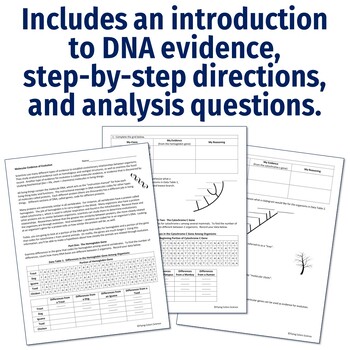Molecular DNA Evidence of Evolution Activity
Flying Colors Science
4.8k Followers
Grade Levels
7th - 10th
Subjects
Resource Type
Standards
NGSSMS-LS4-3
NGSSHS-LS4-1
NGSSMS-LS4-2
NGSSMS-LS4-4
Formats Included
- PDF
- Google Apps™
- Easel Activity
Pages
3 pages
Flying Colors Science
4.8k Followers

Includes Google Apps™
The Teacher-Author indicated this resource includes assets from Google Workspace (e.g. docs, slides, etc.).
Easel Activity Included
This resource includes a ready-to-use interactive activity students can complete on any device. Easel by TPT is free to use! Learn more.
What educators are saying
Perfect! This is an "essential standard" for us and this did a great job assessing students on the standard.
Great assignment that helps students see how molecular genetics fits into evolution. I especially liked that students had to construct their own cladograms. This was a good challenge, but not too hard for them. This did take quite some time. I could see doing half one day and half the next day.
Also included in
- NO PREP! SAVE BIG when you combine 4 evolution evidence activities! Please click VIEW PREVIEW (above) to take a closer look at each resource!This bundle combines 4 evidence of evolution activities, including:Homologous Structures: Compare and Contrast ActivityVestigial Structures: Reading, AnalysiPrice $10.99Original Price $13.98Save $2.99
- Never search for "something to do tomorrow" ever again! This bundle contains PRINT AND GO lessons, NO PREP activities, LOW PREP labs, and ENGAGING articles to supplement and thoroughly enhance a life science course. Every included resource is easy to implement, standards-based, and high-quality.Price $399.99Original Price $750.85Save $350.86
Description
Genetic evidence of evolution activity - includes GOOGLE SLIDES VERSION!
The level of this activity is suited for students who have very little - if any - background in DNA and protein synthesis. The activity leads students to an "enduring understanding" that the more differences there are in DNA, the further apart two organisms are related, and the further back in time they share a common ancestor.
⭐ Get this activity at a discount in our EVOLUTION ACTIVITY BUNDLE!
In this resource, students will:
- Read a brief and middle school-appropriate introduction about DNA and proteins
- Examine differences in two DNA sequences of several different organisms
- Complete a Claims-Evidence-Reasoning section about which vertebrates are most and least closely related to each other
- Use the information to fill in blanks on a simple cladogram
- Answer concluding analysis questions
Teacher Notes:
- INCLUDES AN ANSWER KEY.
- Please note: This resource is not editable.
- A link to the Google Slides version is provided within the downloadable PDF.
We also have activities for:
Total Pages
3 pages
Answer Key
Included
Teaching Duration
N/A
Report this resource to TPT
Reported resources will be reviewed by our team. Report this resource to let us know if this resource violates TPT’s content guidelines.
Standards
to see state-specific standards (only available in the US).
NGSSMS-LS4-3
Analyze displays of pictorial data to compare patterns of similarities in the embryological development across multiple species to identify relationships not evident in the fully formed anatomy. Emphasis is on inferring general patterns of relatedness among embryos of different organisms by comparing the macroscopic appearance of diagrams or pictures. Assessment of comparisons is limited to gross appearance of anatomical structures in embryological development.
NGSSHS-LS4-1
Communicate scientific information that common ancestry and biological evolution are supported by multiple lines of empirical evidence. Emphasis is on a conceptual understanding of the role each line of evidence has relating to common ancestry and biological evolution. Examples of evidence could include similarities in DNA sequences, anatomical structures, and order of appearance of structures in embryological development.
NGSSMS-LS4-2
Apply scientific ideas to construct an explanation for the anatomical similarities and differences among modern organisms and between modern and fossil organisms to infer evolutionary relationships. Emphasis is on explanations of the evolutionary relationships among organisms in terms of similarity or differences of the gross appearance of anatomical structures.
NGSSMS-LS4-4
Construct an explanation based on evidence that describes how genetic variations of traits in a population increase some individuals’ probability of surviving and reproducing in a specific environment. Emphasis is on using simple probability statements and proportional reasoning to construct explanations.








